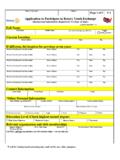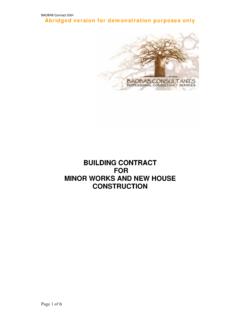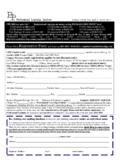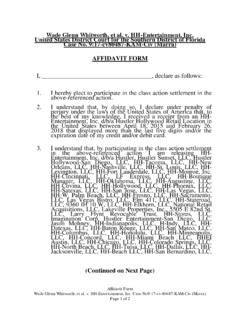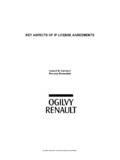Transcription of November 2004 INDEMNITIES, PART 2: …
1 I Copyright 2004. All rights , PART 2:CONSULTANT-FRIENDLY AGREEMENTSThe following material is provided for informational purposes only. Before taking any action that could have legal or otherimportant consequences, speak with a qualified professional who can provide guidance that considers your own uniquecircumstances. We would like to thank XL Insurance for their significant contribution to this agreements originated in the construction industry to hold owners harmless from liabilities that arose duringconstruction. Since the contractor has 100% control of the job site, it s only fair that the contractor should indemnify ( ,hold harmless) the owner for any site-related problems that arise. Over time, however, the fairness concept behindindemnification has been corrupted. Today, architects and engineers are often forced to sign contracts that make them assume alarge portion of the owners risk even though they do not have control over those risks.
2 Worse yet, this significant increase inliability assumed through a contractual indemnity is typically uninsurable, spelling double 1 of this two-part report examined the dangers of client-drafted indemnities , identified three types of such indemnities anddemonstrated techniques to persuade a client to abandon the use of these onerous what if a client is insistent upon including an indemnity in your contract? In Part 2, we ll examine alternative forms of clientindemnities that have only limited drawbacks. We ll also address situations in which you may want to ask for a reasonableindemnity from the client, the contractor, your subconsultants and other third Mutual IndemnityThe limited-form indemnity discussed in Part I is definitely the least of the three evils examined previously. An even betteralternative, however, is a mutual indemnity that calls upon each party to indemnify the other, but only for each party s negligentacts.
3 If a client presents you with its own indemnity language, you can counter with a mutual indemnity such as the followingexample from The Contract Guide published by XL Insurance:INDEMNIFICATIONThe Consultant agrees, to the fullest extent permitted by law, to indemnify and hold harmlessthe Client, its officers, directors and employees (collectively, Client) against all damages,liabilities or costs, including reasonable attorneys fees and defense costs, to the extent causedNovember 2004A LOSS PREVENTION PUBLICATION FORTHE DESIGN PROFESSIONAL Copyright 2004. All rights the Consultants negligent performance of professional services under this Agreement andthat of its subconsultants or anyone for whom the Consultant is legally Client agrees, to the fullest extent permitted by law, to indemnity and hold harmless theConsultant, its officers, directors, employees and subconsultants (collectively, Consultant)against all damages, liabilities or costs, including reasonable attorneys fees and defense costs,to the extent caused by the Client s negligent acts in connection with the Project and the acts ofits contractors, subcontractors or consultants or anyone for whom the Client is legally the Client nor the Consultant shall be obligated to indemnify the other party in anymanner whatsoever for the other party s Insurable IndemnityAs a decidedly less desirable alternative, you may consider giving an insistent client some type of unilateral indemnity that limitsthe indemnity to that which is insurable.
4 Tie the indemnity to your negligence and purge any client-generated clause of onerouslanguage. Include the concept of comparative negligence, which holds you liable for only the portion of the damages for which youare responsible (unless your state law has an even more protective provision). Finally, see that the indemnity is limited to theservices called for under the agreement. These concepts are reflected in the following sample language from XL Consultant agrees, to the fullest extent permitted by law, to indemnify and hold harmlessthe Client against damages, liabilities and costs arising from the negligent acts of theConsultant in the performance of professional services under this Agreement, to the extent thatthe Consultant is responsible for such damages, liabilities and costs on a comparative basis offault and responsibility between the Consultant and the Client. The Consultant shall not heobligated to indemnify the Client for the Client s own the Client Won t BudgeIf the client refuses to accept any alteration of an onerous indemnification, you have a business decision to make.
5 You can acceptthe clause and the risk, hoping that the client will not ever have to apply the indemnity. Realize, however, that you are openingyourself up to an unlimited financial exposure that virtually no professional liability insurance policy will cover. This optionshould only be considered with a very low-risk client and project type with which your firm is thoroughly familiar and has had aclaim-free record of foolproof approach, of course, is to decline any engagement that includes an onerous indemnity provision. This is a decisionthat may lose you an otherwise attractive client or project, but it may be the prudent choice to ensure your long-term who knows: your willingness to hold your ground and walk away from the work because of the indemnity clause may justearn you the client s respect and perhaps result in an eleventh hour change of heart in demanding an unfair and uninsurablecontractual You Want an Indemnity from Your ClientAs stated, the original concept of indemnity is based in fairness, and no consultant should be overly reluctant to indemnify an ownerfrom the design firm s own negligence, errors or omissions.
6 Likewise, there are certain instances where a design firm should notaccept work on a project unless the client is willing to indemnify the consultant from unusual risks. Such instances may involvehazardous waste, asbestos, condominiums, renovations or the possible unauthorized reuse of your design Copyright 2004. All rights , there are times when an indemnity from your client is the only prudent approach. Your firm did not create the hazards andyour role is to help the client overcome them. In high-risk projects, an indemnity from the owner should be a requirement for yourservices. Such a contractual clause might read like the following sample from XL Insurance:INDEMNIFICATIONThe Client agrees, to the fullest extent permitted by law, to indemnify and hold harmless theConsultant, its officers, directors, employees and subconsultants (collectively, Consultant)against all damages, liabilities or costs including reasonable attorneys fees and defensecosts, arising out of or in any way connected with this Project or the performance by any ofthe parties above named of the services under this Agreement, excepting only thosedamages, liabilities or costs attributable to the negligent acts or negligent failure to act bythe additional protection on very risky projects, particularly those involving hazardous conditions that you can t control orproperly insure, talk to your attorney about the viability of asking your client for a waiver -- an agreement from the client not to sueyou.
7 A waiver is one of the most difficult provisions to obtain and to enforce, and some states have strict statutes applying towaivers. Therefore, keep the waiver and indemnity separate so that if the waiver is ruled invalid the indemnity isn t thrown out withit. Here is a sample waiver from XL Insurance:WAIVERIn consideration of the substantial risks to the Consultant in rendering professional services inconnection with this Project, the Client agrees to make no claim and hereby waives, to thefullest extent permitted by law, any claim or cause of action of any nature against theConsultant, his or her officers, directors, employees, agents or subconsultants, which may ariseout of or in connection with this Project or the performance by any of the parties above namedof the services under this Party IndemnitiesIn the event of jobsite injuries to workers or others, architects and engineers are often included in the resulting claims.
8 For protec-tion against these and other third-party claims, add a clause to your client contract that requires the client to include provisions inthe client-contractor contract requiring the contractor to 1) have adequate insurance and 2) indemnify you and the owner for claimsby the contractor s employees. Here is sample language from XL Insurance:CONTRACTOR INSURANCE AND INDEMNITY REQUIREMENTSThe Client agrees, in any construction contracts in connection with this Project, to require allcontractors of any tier to carry statutory Workers Compensation, Employers LiabilityInsurance and appropriate limits of Commercial General Liability Insurance (CGL). TheClient further agrees to require all contractors to have their CGL policies endorsed to name theClient, the Consultant and its subconsultants as Additional Insureds and to provideContractual Liability coverage sufficient to insure the hold harmless and indemnityobligations assumed by the contractors.
9 The Client shall require all contractors to furnish tothe Client and the Consultant certificates of insurance as evidence of the required insuranceprior to commencing work and upon renewal of each policy during the entire period ofconstruction. In addition, the Client shall require that all contractors will, to the fullest extentpermitted by law, indemnify and hold harmless the Client, the Consultant and itssubconsultants from and against any damages, liabilities or costs, including reasonable4 Copyright 2004. All rights s fees and defense costs, arising out of or in any way connected with the Project,including all claims by employees of the From SubconsultantsPrime consultants may seek indemnities from their subconsultants to protect themselves from damages and costs arising from claimsdue to the actions of these subconsultants. Consider the following language from XL Insurance:INDEMNIFICATIONThe Consultant and the Subconsultant mutually agree, to the fullest extent permitted by law, toindemnify and hold each other harmless against all damages, liabilities or costs, includingreasonable attorneys fees and defense costs, arising from their own negligent acts in theperformance of their services under this Agreement, to the extent that each party is responsiblefor such damages, liabilities and costs on a comparative are complex and have enormous liability implications.
10 Have your attorney draft or approve any indemnity languagewith respect to the laws of the governing jurisdiction to determine exactly what your rights and exposures may be. Work, too, withus, your professional liability insurance specialist, to determine the insurability of any indemnities you intend to We Be of Assistance?We may be able to help you by providing referrals to consultants, and by providing guidance relative to insurance issues, and evento certain preventives, from construction observation through the development and application of sound human resources manage-ment policies and procedures. Please call on us for assistance. We re a member of the Professional Liability Agents Network(PLAN). We re here to MORE INFORMATION, CONTACT:Poole Professional Edgewater Place, Suite 180 Wakefield, MA 01880 Tel: 781 245-5400 Fax: 781 Professional No. 17th St., Suite 1200 Philadelphia, PA 19103-2703 Tel: 215 564-6970 Fax: 215 Professional - New York, M.


